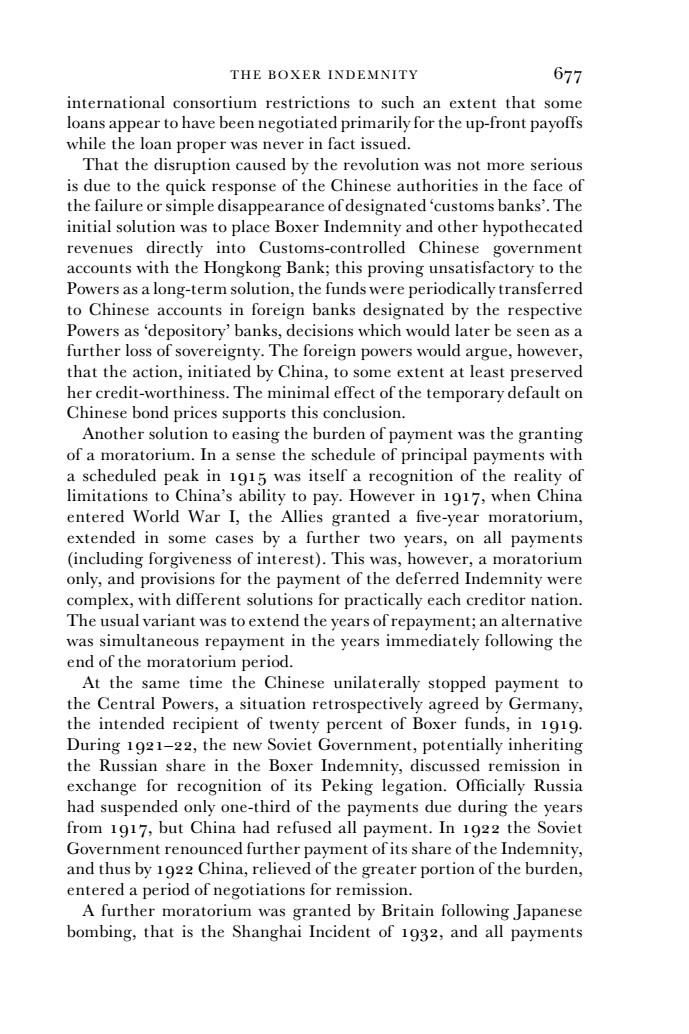正在加载图片...

THE BOXER INDEMNITY 677 international consortium restrictions to such an extent that some loans appear to have been negotiated primarily for the up-front payoffs while the loan proper was never in fact issued. That the disruption caused by the revolution was not more serious is due to the quick response of the Chinese authorities in the face of the failure or simple disappearance of designated 'customs banks'.The initial solution was to place Boxer Indemnity and other hypothecated revenues directly into Customs-controlled Chinese government accounts with the Hongkong Bank;this proving unsatisfactory to the Powers as a long-term solution,the funds were periodically transferred to Chinese accounts in foreign banks designated by the respective Powers as 'depository'banks,decisions which would later be seen as a further loss of sovereignty.The foreign powers would argue,however, that the action,initiated by China,to some extent at least preserved her credit-worthiness.The minimal effect of the temporary default on Chinese bond prices supports this conclusion. Another solution to easing the burden of payment was the granting of a moratorium.In a sense the schedule of principal payments with a scheduled peak in 1915 was itself a recognition of the reality of limitations to China's ability to pay.However in 1917,when China entered World War I,the Allies granted a five-year moratorium, extended in some cases by a further two years,on all payments (including forgiveness of interest).This was,however,a moratorium only,and provisions for the payment of the deferred Indemnity were complex,with different solutions for practically each creditor nation. The usual variant was to extend the years of repayment;an alternative was simultaneous repayment in the years immediately following the end of the moratorium period. At the same time the Chinese unilaterally stopped payment to the Central Powers,a situation retrospectively agreed by Germany, the intended recipient of twenty percent of Boxer funds,in 1919. During 1921-22,the new Soviet Government,potentially inheriting the Russian share in the Boxer Indemnity,discussed remission in exchange for recognition of its Peking legation.Officially Russia had suspended only one-third of the payments due during the years from 1917,but China had refused all payment.In 1922 the Soviet Government renounced further payment of its share of the Indemnity, and thus by 1922 China,relieved of the greater portion of the burden, entered a period of negotiations for remission. A further moratorium was granted by Britain following Japanese bombing,that is the Shanghai Incident of 1932,and all paymentsTHE BOXER INDEMNITY 677 international consortium restrictions to such an extent that some loans appear to have been negotiated primarily for the up-front payoffs while the loan proper was never in fact issued. That the disruption caused by the revolution was not more serious is due to the quick response of the Chinese authorities in the face of the failure or simple disappearance of designated ‘customs banks’. The initial solution was to place Boxer Indemnity and other hypothecated revenues directly into Customs-controlled Chinese government accounts with the Hongkong Bank; this proving unsatisfactory to the Powers as a long-term solution, the funds were periodically transferred to Chinese accounts in foreign banks designated by the respective Powers as ‘depository’ banks, decisions which would later be seen as a further loss of sovereignty. The foreign powers would argue, however, that the action, initiated by China, to some extent at least preserved her credit-worthiness. The minimal effect of the temporary default on Chinese bond prices supports this conclusion. Another solution to easing the burden of payment was the granting of a moratorium. In a sense the schedule of principal payments with a scheduled peak in 1915 was itself a recognition of the reality of limitations to China’s ability to pay. However in 1917, when China entered World War I, the Allies granted a five-year moratorium, extended in some cases by a further two years, on all payments (including forgiveness of interest). This was, however, a moratorium only, and provisions for the payment of the deferred Indemnity were complex, with different solutions for practically each creditor nation. The usual variant was to extend the years of repayment; an alternative was simultaneous repayment in the years immediately following the end of the moratorium period. At the same time the Chinese unilaterally stopped payment to the Central Powers, a situation retrospectively agreed by Germany, the intended recipient of twenty percent of Boxer funds, in 1919. During 1921–22, the new Soviet Government, potentially inheriting the Russian share in the Boxer Indemnity, discussed remission in exchange for recognition of its Peking legation. Officially Russia had suspended only one-third of the payments due during the years from 1917, but China had refused all payment. In 1922 the Soviet Government renounced further payment of its share of the Indemnity, and thus by 1922 China, relieved of the greater portion of the burden, entered a period of negotiations for remission. A further moratorium was granted by Britain following Japanese bombing, that is the Shanghai Incident of 1932, and all payments